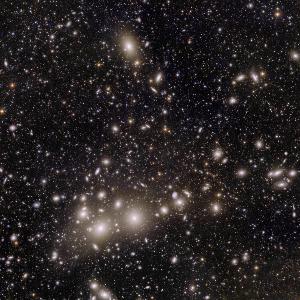Extragalactic Astronomy
The Extragalactic Astronomy Research Group at the USM investigates the structure and evolution of galaxies and their distribution in space and time.

The Extragalactic Astronomy Research Group at the USM investigates the structure and evolution of galaxies and their distribution in space and time.

USM's Extragalactic Astronomy Research Group, led by Prof. Ralf Bender and senior staff Dr. Ulrich Hopp, Dr. Stella Seitz, and Dr. Arno Riffeser, and the Optical and Interpretative Astronomy Group (OPINAS) of the Max Planck Institute for Extraterrestrial Physics (MPE) constitute a joint research group which is also closely tied with USM's Physical Cosmology Group. We investigate the structure and evolution of galaxies and their distribution in space and time, e.g. employing imaging and spectroscopy at optical and infrared wavelengths to study their stellar populations, their internal dynamics, and mass distributions. We also use the gravitational lens effect to analyse the nature of Dark Matter in and around galaxies and galaxy clusters. The large-scale distribution of galaxies and gravitational lensing also provide direct insight into the properties of Dark Energy. In the nearby universe, we search for extrasolar planets and explore their properties with transits and radial velocities.
Our group also has a strong instrumentation activity. We have regularly built instruments for the Very Large Telescope of the European Southern Observatory (FORS, OmegaCAM, KMOS) and we are heavily involved in the construction of the First-Light Camera MICADO for the 39m Extremely-Large-Telescope of ESO. This gives us guaranteed access to these world-leading telescopes and enables ambitious and unique observational projects in our research areas. Our group also operates the Mt. Wendelstein Observatory in the Bavarian Alps for which we build all instrumentation and which serves as a test-bed for technology development. The Wendelstein 2m telescope gives bachelor and master students easy and direct access to a modern high-technology telescope and allows them to participate in observations and instrument development early in their education. Last not least, we are also a partner in a range of projects which focus on Dark Energy Research: 10m Hobby-Eberly-Telescope in West Texas, the Dark Energy Survey (DES), the ESA EUCLID space mission, and the Rubin observatory’s Legacy Survey of Space and Time (LSST).
The Optical and Interpretative Astronomy group at MPE and the Ludwig-Maximilians-University Observatory under the leadership of Ralf Bender investigates the evolution of cosmological structures ranging from small to large scales, with special focus on:
Researchers in the Physical Cosmology Group, led by Prof. Dr. Jochen Weller, at the University Observatory, are confronting modern cosmological theories with observations. They have a strong research program in exploring galaxy clusters and cosmic voids, but also explore more general probes of the large-scale structure and the cosmic microwave background.
Associated with the Extragalactic Astronomy Group, the research group led by Dr. Stella Seitz uses the gravitational lens effect to study our universe with focus on the statistical properties of the large scale structure’s dark matter field as it evolves with the Universe.
Ariel Sanchez' team focusses on observational cosmology and the study of the large-scale structure of the Universe. They are interested in the combination of theoretical work with new precise observations, particularly in the analysis of baryonic acoustic oscillations (BAO) and redshift-space distortions (RSD) in the galaxy density field, to obtain robust percent-level cosmological constraints, with emphasis on the accurate determination of the properties of dark energy and potential deviations from Einstein's theory of General Relativity.
The USM Exgal group also operates the Wendelstein Observatory with its 2m-Fraunhofer telescope at 1840m altitude in the Bavarian alps. Just a one-hour drive from Munich, the observatory on top of the rocky mountin is not just a sight to be seen, but also a highly modern research facility.
| Name | Tel | Position | |
|---|---|---|---|
| Bender, Ralf | dekanat17@lmu.de | +498921805999 | Dean of the Faculty of Physics |
| Weller, Jochen | jochen.weller@lmu.de | +498921805976 | Professor, Dean of Studies |
| Name | Position | |
|---|---|---|
| Seitz, Stella | stella@usm.lmu.de | Senior Staff Astronomer |
| Riffeser, Arno | arri@usm.lmu.de | Senior Staff Astronomer |
| Saglia, Roberto | saglia@mpe.mpg.de | Lecturer |
| Sanchez, Ariel | arielsan@mpe.mpg.de | Lecturer |
| Fabricius, Maximilian | mxhf@mpg.mpe.de | Senior Staff Astronomer |
| Thomas, Jens | jthomas@mpe.mpg.de | Senior Staff Astronomer |
| Name | Position | |
|---|---|---|
| Barthélemy, Alexandre | alexandre.barthelemy@usm.lmu.de | Fraunhofer-Schwarzschild-Fellow |
| Chon, Gayoung | gchon@usm.lmu.de | Lecturer |
| Varga, Tamas Norbert | vargatn@usm.lmu.de | Staff Scientist |
| Neureiter, Bianca | bneu@mpe.mpg.de | Staff Scientist |
| De Nicola, Stefano | denicola@mpe.mpg.de | Research Fellow |
| Parikh, Taniya | tparikh@mpe.mpg.de | Staff Scientist |
| Name | Position | |
|---|---|---|
| Gong, Laurence Zhengyangguang | lgong@usm.lmu.de | PhD Student |
| Halder, Anik | ahalder@usm.lmu.de | Post-Doc |
| Queirolo, Giacomo | queirolo@usm.lmu.de | PhD Student |
| Zöller, Raphael | rzoeller@usm.lmu.de | PhD Student |
| Thomas, Luis | lthomas@usm.lmu.de | PhD Student |
| Lipka, Matthias | mlipka@mpe.mpg.de | PhD Student |
| Mehrgan, Kianush | kmehrgan@mpe.mpg.de | Research Fellow |
| Semenaite, Agne | agne@mpe.mpg.de | PhD Student |